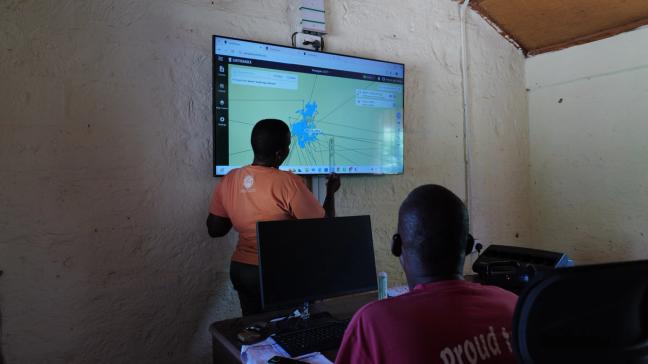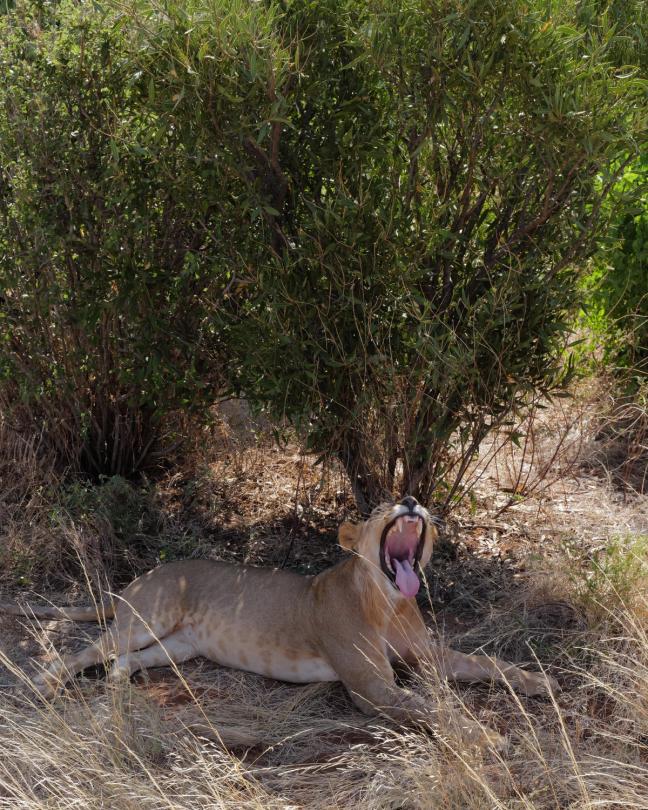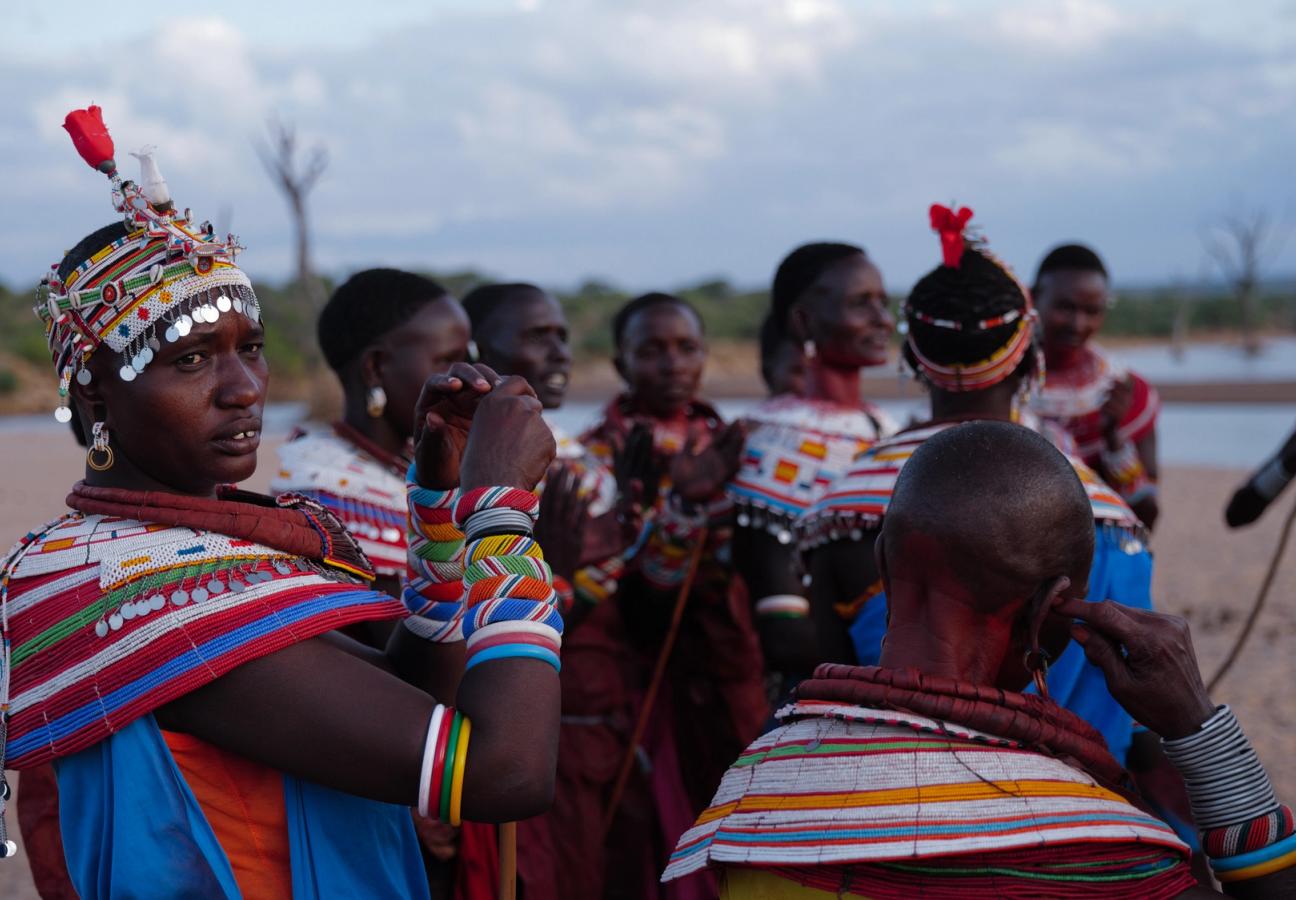Luxury Safari Camp Sasaab: Leading the Way in Sustainable Travel
Experience the magic of Northern Kenya this winter and learn how Sasaab’s romantic getaway meets purpose through community-led conservation in the heart of Samburu
Imagine being on a sandy riverbank, as the world around comes to life. Armed with freshly brewed coffee, the early dawn sun streaming over distant mountain tops, casting a warm, golden light across a dramatic landscape. The sound of birdsong ringing out under a pale blue sky as starlings, hornbills, and weavers swoop and swirl overhead. The murky waters of the Ewaso Nyiro River ebb and flow over the rocky dry earth, marking the boundary between Isiolo County and the land of the Samburu people. Welcome to Sasaab – where luxury adventure and meaningful conservation collide in Samburu’s wild heart.


Majestic giants at dawn: Up close and personal
A subtle rustling of bushes signals their arrival. Cautiously, she emerges just feet away, having barely made a sound while forging a path through the undergrowth. Carefully, I raise my Leica SL3 to capture the moment, as she strides steadily toward the water’s edge. Submerging her coarse, powerful trunk — comprised of an astonishing 40,000 muscles and capable of drawing up to 12 litres of water — she quenches her thirst. As the matriarch of her group, the herd depends on her leadership and decision-making to safely navigate the vast and often arid territories of Northern Kenya.

Slowly but surely, a staggering 32 more elephants, escorted by an enormous bull, join her at the riverbank, gingerly stepping out from the thorny shrubbery of boscias and acacias to cool off and bask in the morning sun. You’d think such large mammals, weighing several tonnes each, would struggle to move through the thicket undetected. But aside from the occasional crackle of branches breaking to satisfy their audacious appetites — consuming up to 300 kilograms of foliage per day — their proximity would be largely unbeknownst to you and me.

My hosts, and proud owners of Sasaab, Tanya and Mikey Carr-Hartley, founded the Safari Collection, a group of luxury camps and lodges in some of the most beautiful locations in Kenya, where sustainability and conservation are at the forefront of the agenda. They softly explain how after years of being protected, studied, and respected in this region, “the elephants have become accustomed to humans and no longer perceive us as a threat.” As the alpha male towers over our canvas-covered Land Cruiser, he sizes us up. Thick white tusks emanate from his giant head, as broad as the vehicle itself. He calmly accepts our presence and turns his attention towards the herd.



Paul Allen’s legacy: Conservation and technology
Meanwhile, Oli Dreike, who is responsible for the Safari Collection’s sustainability and philanthropic division, Footprint, eagerly taps away on his iPhone. Turns out he’s not uploading #elephantselfies, but in fact logging our sightings into an app called ‘EarthRanger’. The software, developed by Vulcan Inc. — founded by late Microsoft co-founder Paul G. Allen — feeds into a database that conservationists use to track wildlife movements, anti-poaching patrols, and even invasive plant species. EarthRanger, Allen’s gift to the conservation world and free for those actively engaged in preserving the natural environment, has significantly improved data collection and monitoring, successfully highlighting the positive impact of new initiatives and areas that require further attention.


Back in 2014, Vulcan Inc. funded and orchestrated the Great Elephant Census, an aerial survey spanning 18 countries across Africa. It was the largest of its kind and revealed a significant decline in elephant populations, primarily due to habitat loss, poaching, and the illegal ivory trade. The census sparked global conservation efforts to protect elephants and prevent future atrocities or endangerment. As a result, strict bans on domestic ivory trade in countries like the US, UK, and China, partly influenced by the census findings, have helped reduce demand and set a global precedent. Engaging with local communities and prioritising anti-poaching efforts has been vital in achieving this goal.

Restoring the environment: The impact of spades
Human-wildlife conflict has long been an issue in Africa, where herders and grazers compete for scarce grasslands. A mid-morning visit to HQ, the nerve centre of operations at the West Gate Conservancy, reveals how organisations like ‘Just Dig It’ have taught local communities how to combat land degradation through simple yet effective techniques like water bunding and grass planting. Known as ‘earth smiles’, the bunds trap water, preventing surface run-off, and provide beds for the grass to grow. The resulting seed then scatters in the wind — eventually creating a carpet of green all around.


This initiative has revitalised vast areas of scorched earth into luscious pastureland, cooling the environment and providing sustainable sources of nutrition and water so, wildlife and agriculture can coexist in harmony. “Carbon sequestration in these grasslands is comparable to kelp beds or forests,” explains rangelands coordinator Alex Lekalaile. “Carbon funds have allowed local communities to implement these techniques, so they can now harvest and collect seed banks to sell to other conservancies looking to replicate these successful projects.”

A force for good: Wellness and the power of travel
Back at the ranch, a late morning massage in the peaceful spa helps ease away muscular tension and unwind after a busy morning traversing rugged slopes and dusty tracks. Strategically located opposite is the 4Cs learning centre, so those seeking wellness can also find out about the causes directly benefiting from their stay. A quick tour and you’ll learn how a proportion of every Sasaab booking fee is allocated directly towards supporting the community with things like health clinics, education, and wildlife protection initiatives like the Grevy’s Zebra Trust.


“Tourism can significantly affect delicate ecosystems,” warns Dreike over a sumptuous lunch of locally sourced miso pork belly and fresh vegetable slaw, grown in Sasaab’s very own veg garden. “When poorly managed, tourism can be devastating, but when done responsibly, it has the power to be hugely beneficial.” Collaborating with tribal elders of the West Gate Community Conservancy, where Sasaab operates, the Samburu have become deeply engaged in managing and preserving their environment, not only for themselves but to help encourage tourism which in turn brings opportunities to their community. They make up 75% of the workforce at Sasaab and many are funded to train as chefs, masseuses, mechanics, guides, blacksmiths and more.

In it for the Long Run: Sustainability’s highest accolade
In 2022, Sasaab was awarded the highly prestigious ‘Global Ecosphere Retreat’ status, recognising its commitment to having a net positive impact on the environment and surrounding communities. Constantly reassessing against a comprehensive list of stringent criteria, The Long Run organisation helps its members achieve the four core values of conservation, community, culture, and commerce — known as the 4Cs.

A key part of this is understanding and celebrating local heritage and tradition. Late in the afternoon, our Samburu guides, Daudi and Leresh, take us to see a ritualistic performance by women from their tribe. Adorned in intricately patterned bead necklaces and headdresses, passed down through generations and representing the unity and fertility they seek, the women chant and dance beside the river as the setting sun casts long shadows over the sandy banks. Traditionally, the women are relied upon to invoke the favour of their god Nkai to bring rain during times of drought. The ‘rain dance’, performed for several hours each day when water is scarce, demonstrates their deep spiritual connection with Nkai, each other, and the natural world, giving them the strength to endure.

Evenings under the stars: The Sasaab experience
As the sun dips below the horizon, we knock back a few ice-coldG&Ts and some crisp South African Chardonnay to boot. In the distance, a troop of a hundred or more baboon ambles its way back to the safety of nearby treetops for the night. Under the fading light we head towards our final destination: a three-course, candlelit dinner under a sea of stars, the Milky Way so vivid it feels within arm’s reach. A few glasses of red, harissa-roasted butternut squash and rare beef tenderloin, expertly prepared over an open fire by Sasaab’s head chef Solomon, is the perfect conclusion to an unforgettable day in the Samburu wilderness. After a nightcap back at Sasaab’s airy Moroccan bar, looking out over the never-ending moonlit scenery below, we meander back to oversized double beds to fall asleep under the stars and dream about Africa’s awe-inspiring beauty.



Sasaab is part of the Safari Collection. With four lodges and a mobile camp to choose from, why not try a safari hop by plane or helicopter. Luxury tour operator Black Tomato makes logistical planning for customisable safaris in Kenya seamless. This particular safari covers 8 nights, including 3 nights at Sasaab, prices starting at $16,000 per person, based on 2 travellers.
Interested in more amazing ways to travel sustainably? Exploring the Wilderness: Kenya and Patagonia (on Horseback)

Become a Gentleman’s Journal Member?
Like the Gentleman’s Journal? Why not join the Clubhouse, a special kind of private club where members receive offers and experiences from hand-picked, premium brands. You will also receive invites to exclusive events, the quarterly print magazine delivered directly to your door and your own membership card.


